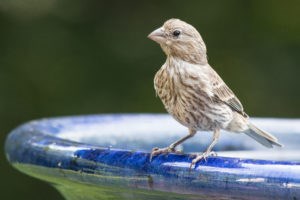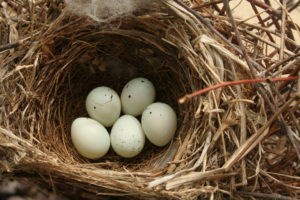This content was originally published by the Longmont Observer and is licensed under a Creative Commons license.
With a splash of red, male house finches make quite an impression at bird feeders. Some enterprising pet store owners in New York in the 1940s tried to sell house finches as “Hollywood finches.” When they were unsuccessful, they let the birds go to escape prosecution. House finches were originally only found in the western US, but with the release in New York, house finches soon spread across the country and can now be found throughout the US. Although they have done well for themselves, they may be beginning to outcompete purple finches.
House finches have small bodies and relatively large beaks that are used to hull seeds. Mature males have red around the head and breast with a streaked brown back, breast, and tail. When flying, males have a distinctive red rump. The red color on the male house finch comes from pigments in the food they eat. Because of this, males may also exhibit orange or yellow colors on their face and breasts. Females tend to prefer males with red coloration. The adult female house finch does not have any red; instead, they are greyish brown with indistinct streaks. House finches fly in an undulating pattern.

House finches can be found where humans are found. In the West, their original habitat, they can also be found in desert environments and open coniferous forests below 6,000 feet. With the exception of the breeding season, house finches are gregarious and occur in large flocks. In addition to eating at feeders, they will forage on the ground and on weed stalks. Finches eat only plant foods including seeds, buds, and fruit. At bird feeders, they prefer black oil sunflowers.
House finches begin to form pairs during the winter. Males will give a breeding display in flight, singing while flying with slow wingbeats. During courtship, males will also feed the females. The feeding ritual begins with the female simulating begging by pecking at the male’s bill. The male then simulates regurgitation a few times before actually feeding the female. This typically occurs after the male and female have been together for a few weeks and about a month before nest building begins.

The nest of the house finch consists of fine stems, leaves, twigs, and feathers and is lined with fine materials such as string or grass. The outside of the nest is 3-7 inches across with the inside cup being 1-3 inches across and 2 inches deep. The nest is mostly built by the female. House finches will nest in both coniferous and deciduous trees, cactus, and rock ledges. They also make good use of manmade structures such as buildings, vents, street lights, and hanging planters. Very rarely will house finches use abandoned nests of other species.
House finches lay 2-6 eggs per clutch. Eggs are incubated for 13-14 days. While the female is incubating the eggs, the male will feed her. Once the eggs hatch, the male helps feed the nestlings. Unlike many other species, the house finch feeds nestlings strictly vegetation rather than feeding protein-rich insects. Nestlings leave the nest at 12-19 days. House finches may have up to three broods per year, and in some cases, have been known to have up to six broods.
Male house finches will sing year-round, whereas females tend to sing mostly in the spring. House sparrows make a chirping call similar to that of the house sparrow. It’s song is a series of warbling notes ending with a “zeee” sound. Males will sing from a high perch for an extended period of time. Watch your bird feeders for the beautiful male and listen for their songs. You are sure to be rewarded.


